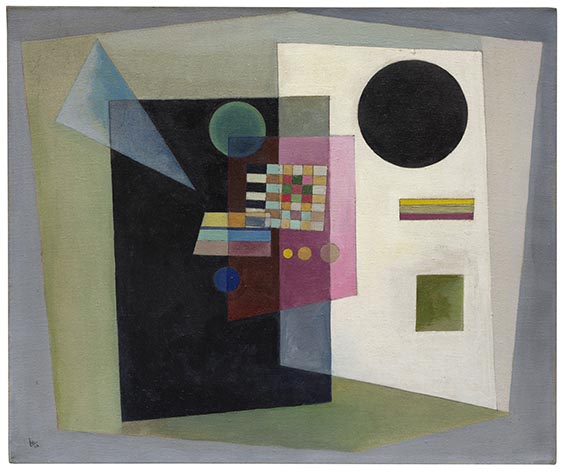Dictionary


Geometric Abstraction before 1945
At the beginning of the 20th century, there was an increasing tendency to move away from objectivity and towards abstraction, and assign colours and forms autonomous value. This tendency can be divided into two main strands - one was rational, geometric abstraction, and the other spiritual-psychological abstraction, led by its main exponent, Kandinsky.
The origins of Geometric Abstraction are complex. Important theoretical conditions made mathematics the objective basis, and additionally, analogous to music and harmony teaching, the notion of the systematic activation of feelings via music and sound. Cubism was also highly influential, with its formal dissection and division of pictorial space. Piet Mondrian (1872-1944) even travelled to Paris to study Cubist art in its context, returning to Holland in 1914, where he introduced a hitherto unrivalled, strict geometric style to the country, as part of the De Stijl movement.
Geometric Abstraction had both a speedy and heterogeneous development in Europe. It began in 1910 in France with František Kupka, Robert Delaunay and Sonia Delaunay-Terk. In Russia, Kasimir Malevich practised Suprematism from 1913. The De Stijl movement began in 1917, led by Piet Mondrian and Theo van Doesburg, and in the 1920s Wassily Kandinsky and Georg Muche introduced the style at the Bauhaus. Other exponents of geometric abstraction included Otto Freundlich, Auguste Herbin, Alberto Magnelli and Richard Mortensen.
The stylistic characteristics of Geometric Abstraction include a focus on geometric base forms, rhythmical colour fields, an emphasis on lines, and (right) angles, as well as the basic logical and structural organisation of the work. These means of expression are also formal attributes of Concrete Art, which however, due to its differing theoretical basis, is fundamentally unlike Geometric Abstraction. Concrete Art has no relation to external reality, and is thus not an abstraction of it, but rather creates its own artistic reality.
At the beginning of the 20th century, there was an increasing tendency to move away from objectivity and towards abstraction, and assign colours and forms autonomous value. This tendency can be divided into two main strands - one was rational, geometric abstraction, and the other spiritual-psychological abstraction, led by its main exponent, Kandinsky.
The origins of Geometric Abstraction are complex. Important theoretical conditions made mathematics the objective basis, and additionally, analogous to music and harmony teaching, the notion of the systematic activation of feelings via music and sound. Cubism was also highly influential, with its formal dissection and division of pictorial space. Piet Mondrian (1872-1944) even travelled to Paris to study Cubist art in its context, returning to Holland in 1914, where he introduced a hitherto unrivalled, strict geometric style to the country, as part of the De Stijl movement.
Geometric Abstraction had both a speedy and heterogeneous development in Europe. It began in 1910 in France with František Kupka, Robert Delaunay and Sonia Delaunay-Terk. In Russia, Kasimir Malevich practised Suprematism from 1913. The De Stijl movement began in 1917, led by Piet Mondrian and Theo van Doesburg, and in the 1920s Wassily Kandinsky and Georg Muche introduced the style at the Bauhaus. Other exponents of geometric abstraction included Otto Freundlich, Auguste Herbin, Alberto Magnelli and Richard Mortensen.
The stylistic characteristics of Geometric Abstraction include a focus on geometric base forms, rhythmical colour fields, an emphasis on lines, and (right) angles, as well as the basic logical and structural organisation of the work. These means of expression are also formal attributes of Concrete Art, which however, due to its differing theoretical basis, is fundamentally unlike Geometric Abstraction. Concrete Art has no relation to external reality, and is thus not an abstraction of it, but rather creates its own artistic reality.
Offers
Headquarters
Joseph-Wild-Str. 18
81829 Munich
Phone: +49 89 55 244-0
Fax: +49 89 55 244-177
info@kettererkunst.de
Louisa von Saucken / Undine Schleifer
Holstenwall 5
20355 Hamburg
Phone: +49 40 37 49 61-0
Fax: +49 40 37 49 61-66
infohamburg@kettererkunst.de
Dr. Simone Wiechers / Nane Schlage
Fasanenstr. 70
10719 Berlin
Phone: +49 30 88 67 53-63
Fax: +49 30 88 67 56-43
infoberlin@kettererkunst.de
Cordula Lichtenberg
Gertrudenstraße 24-28
50667 Cologne
Phone: +49 221 510 908-15
infokoeln@kettererkunst.de
Hessen
Rhineland-Palatinate
Miriam Heß
Phone: +49 62 21 58 80-038
Fax: +49 62 21 58 80-595
infoheidelberg@kettererkunst.de
We will inform you in time.




